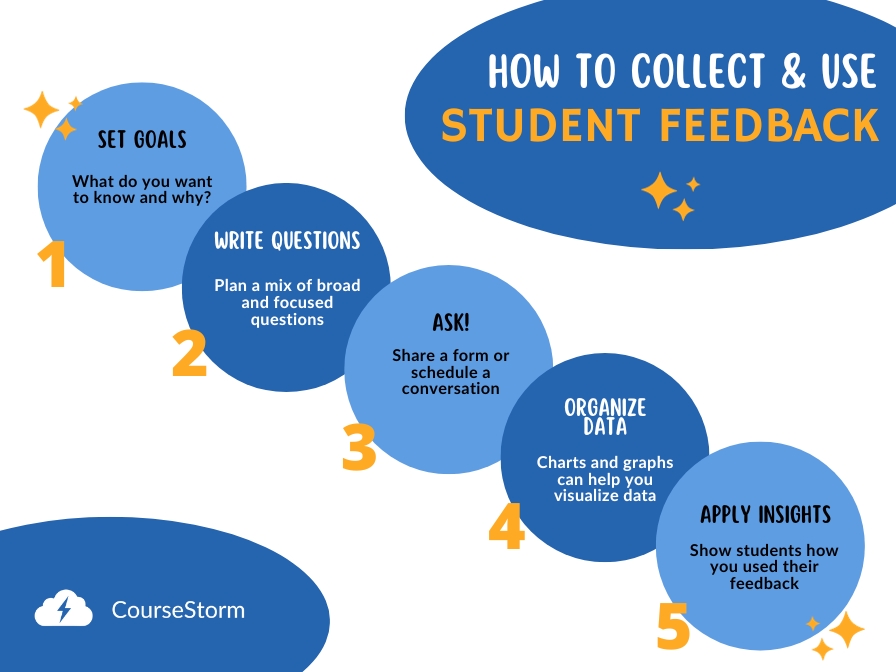Best Practices
How To's
How to Collect and Use Student Feedback to Build Better Programs

Requests for feedback show up on menus, in marketing emails, and even on the back of long-haul trucks. They pop up anywhere organizations interact with the general public. Your education program should be no exception. Collecting student feedback can help you improve your programs and better support your learners.
Most people recognize that feedback is important. What may be less clear is how to collect student feedback and what to do once you have it. Some people also worry about asking for feedback too often or how to handle negative feedback. Here is everything you need to know to create an effective feedback funnel for your education program.
Student Feedback: Your Most Valuable Resource
Feedback can do three important things. First, it gives you information to make decisions about your program and class offerings. Feedback can help you measure progress toward student satisfaction goals. It can also show you where there’s room for improvement in your classes or registration process.
Only about 4% of customers will tell you if they’re unhappy. Asking students for feedback helps you catch and fix issues early and increases loyalty.
Second, asking for feedback helps you catch issues early. Many students won’t complain about small irritations, but they might decide to register somewhere else next time. In fact, only about 4% of dissatisfied customers will tell you they’re unhappy. Specifically requesting feedback can help increase that percentage so you can do something about it.
Third, feedback helps strengthen relationships between programs and learners. A study by Harvard Business Review found that customers were more loyal after being asked for feedback. Just asking for their opinion shows students you care about them and what they have to say.

Setting Feedback Goals
Clearly defining your reason to get feedback will help you craft an approach that will provide you with the best information. Get clear on what you want to know and why you want to know it. Here are some questions that feedback can help answer:
- Why are we not getting the repeat students that we expect?
- How can we increase student referrals?
- Why do we have higher class registrations on specific days?
- Why are students enrolling in our program vs. other programs?
- How do our tuition and fees compare to our students’ expectations?
- How do we compare to other competing activities in our area?
- Are we meeting our students’ needs?
- What’s the overall satisfaction level with our current program?
- Should we stop offering this specific class, or are there things we can do to improve it?
Being clear about what you want to know can help you avoid overwhelming students with too many unrelated questions.
Two Broad Types of Student Feedback
You can gather two broad types of feedback: Solicited and unsolicited. Both are useful in different ways and combining them will often lead to the most accurate insights.
Unsolicited feedback is the thoughts or feelings your students share without being asked. You get this feedback by:
- Watching how students behave
- Monitoring social media and third-party review sites
- Tracking customer engagement and retention
- Listening to student comments
Relying exclusively on spontaneous feedback can mean you only hear the extremes. Students are more likely to speak up when they’re either delighted or angry. For a more nuanced look, create opportunities for intentional sharing.
Solicited feedback is information you collect in a structured way by asking customers for their insights. You get this feedback by:
- Adding feedback links to your emails
- Using course evaluation forms
- Interviewing students directly
- Including feedback questions on your registration forms
- Sending a yearly questionnaire
How to Collect Student Feedback
Students invited to give feedback should be told why they should participate, how long the process will take, and how their feedback will be used. Follow these best practices for optimum results:
1. Ask a mix of focused and broad questions
A survey or feedback form should offer a real opportunity for students to share their experience and opinions. Asking a mix of focused and broad questions helps you find answers to specific questions, but also creates an opening for students to share what’s on their minds.
Focused question: On a scale of 1 to 5, how easy was our registration process?
Broad question: What could we do better?
Broad questions help you collect feedback you might otherwise miss. For example, you may wonder about whether you’re offering the right classes, but students are more concerned about the timing of those classes.
2. Request consent to share
Feedback forms and surveys can sometimes deliver useful gems that could become testimonials. If you hope to use feedback in marketing materials, ask for consent.
Consent to share: Do you give us permission to use your survey responses in print and online marketing materials for the purposes of promoting our courses and programs?
While we’re talking about consent, make sure that respondents know who will see the information and how it will be used. Let them know who will have direct access to the results.
3. Gather demographic data
Demographic data can reveal whether you’re reaching your target audience. It may also help you flag diversity and inclusion issues. Ask some basic questions about the person giving feedback so you have context for their opinions.
Basic demographics: age, race, income level, gender, employment, level of education
Targeted demographics: disabilities, veteran status, location, family and dependents, housing situation, primary language
You don’t need to ask all of these questions on every survey. Pick and choose the ones that align with your goals and information needs.
Tools for Collecting Feedback
Course evaluations – Used to collect feedback about a specific course or class. Course evaluation questions ask about the class content, instructor, teaching methods, and assignments. You can use online tools like Google Forms or printed evaluations handed out in class.
Customer feedback form – Used to collect feedback about the customer experience. These forms might ask about ease of registration, pricing, service, or other elements related to the transaction. You can use Google Forms, or build these questions directly into your registration forms.
Social media polls – Used to collect information from the general public. These are useful for deciding whether to offer a class or getting to know your audience. Various social media platforms allow you to create polls. Using the built-in tools is usually more effective than a DIY solution.
Interviews – Used to gather more in-depth information from specific students. Interviews can be labor-intensive, but may also reveal more nuanced details. Prepare questions in advance and make sure to take notes or record the conversation.
What to Do With All That Feedback Data
Start by organizing your data. Enter all of the responses into a spreadsheet. Many of the online survey forms will do this for you automatically. Make sure to clean up any duplicate or missing data. Then rank or otherwise organize data into logical groupings. You might split positive and negative data or group it by customer demographics.
Next, look for patterns. Do you see themes coming up repeatedly? Are there some questions that people tend to skip? Look for trends in demographics as well as responses. You might also want to highlight answers that are particularly strong.
Then, create visualizations. Make charts, graphs, or highlight sheets to make this data useful for your whole team. Some online survey tools have templates that can help with data visualizations.
How to Use Student Feedback to Improve Programs
If you gather feedback, but don’t use it, students will stop answering your questions. Student feedback is only valuable if you apply it.
Identify which feedback you plan to act on. Some problems can be easily solved with a new tool or messaging, others require a bigger investment. Discuss what’s possible, then identify strategies and timelines.
Don’t forget to tell your students what you’re up to. Showing them how their feedback is used can build trust and make them more likely to respond in the future. That kind of transparency creates loyalty, the greatest gift an enrollment-based program can have. Here’s an example of how PrimeLife Arts Learning created a promotional video from student feedback they collected.
Now that you know how to collect and use student feedback, use our customizable course evaluation template to get started gathering feedback that can improve your classes.

Nic Lyons
Nic is skilled in scaling start-up edtech and education organizations to growth-stage success through innovative marketing. A former journalist and copywriter, Nic holds a postgraduate certificate in digital and print publishing from Columbia University School of Journalism's publishing course.
